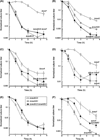Stalled replication fork repair and misrepair during thymineless death in Escherichia coli
- PMID: 20465561
- PMCID: PMC3965187
- DOI: 10.1111/j.1365-2443.2010.01405.x
Stalled replication fork repair and misrepair during thymineless death in Escherichia coli
Abstract
Starvation for DNA precursor dTTP, known as 'thymineless death' (TLD), kills bacterial and eukaryotic cells alike. Despite numerous investigations, toxic mechanisms behind TLD remain unknown, although wrong nucleotide incorporation with subsequent excision dominates the explanations. We show that kinetics of TLD in Escherichia coli is not affected by mutations in DNA repair, ruling out excision after massive misincorporation as the cause of TLD. We found that the rate of DNA synthesis in thymine-starved cells decreases exponentially, indicating replication fork stalling. Processing of stalled replication forks by recombinational repair is known to fragment the chromosome, and we detect significant chromosomal fragmentation during TLD. Moreover, we report that, out of major recombinational repair functions, only inactivation of recF and recO relieves TLD, identifying the poisoning mechanism. Inactivation of recJ and rep has slight effect, while the recA, recBC, ruvABC, recG and uvrD mutations all accelerate TLD, identifying the protection mechanisms. Our epistatic analysis argues for two distinct pathways protecting against TLD: RecABCD/Ruv repairs the double-strand breaks, whereas UvrD counteracts RecAFO-catalyzed toxic single-strand gap processing.
Figures







Similar articles
-
Pathways of resistance to thymineless death in Escherichia coli and the function of UvrD.Genetics. 2011 Sep;189(1):23-36. doi: 10.1534/genetics.111.130161. Epub 2011 Jul 29. Genetics. 2011. PMID: 21705756 Free PMC article.
-
Thymineless Death in Escherichia coli Is Unaffected by Chromosomal Replication Complexity.J Bacteriol. 2019 Apr 9;201(9):e00797-18. doi: 10.1128/JB.00797-18. Print 2019 May 1. J Bacteriol. 2019. PMID: 30745374 Free PMC article.
-
Role of RecA and the SOS response in thymineless death in Escherichia coli.PLoS Genet. 2010 Mar 5;6(3):e1000865. doi: 10.1371/journal.pgen.1000865. PLoS Genet. 2010. PMID: 20221259 Free PMC article.
-
Replication Fork Breakage and Restart in Escherichia coli.Microbiol Mol Biol Rev. 2018 Jun 13;82(3):e00013-18. doi: 10.1128/MMBR.00013-18. Print 2018 Sep. Microbiol Mol Biol Rev. 2018. PMID: 29898897 Free PMC article. Review.
-
Thymineless Death Lives On: New Insights into a Classic Phenomenon.Annu Rev Microbiol. 2015;69:247-63. doi: 10.1146/annurev-micro-092412-155749. Epub 2015 Aug 7. Annu Rev Microbiol. 2015. PMID: 26253395 Review.
Cited by
-
Thymineless death is inhibited by CsrA in Escherichia coli lacking the SOS response.DNA Repair (Amst). 2013 Nov;12(11):993-9. doi: 10.1016/j.dnarep.2013.08.011. Epub 2013 Sep 25. DNA Repair (Amst). 2013. PMID: 24075571 Free PMC article.
-
Maladaptive DNA repair is the ultimate contributor to the death of trimethoprim-treated cells under aerobic and anaerobic conditions.Proc Natl Acad Sci U S A. 2017 Oct 24;114(43):11512-11517. doi: 10.1073/pnas.1706236114. Epub 2017 Oct 9. Proc Natl Acad Sci U S A. 2017. PMID: 29073080 Free PMC article.
-
Disintegration of nascent replication bubbles during thymine starvation triggers RecA- and RecBCD-dependent replication origin destruction.J Biol Chem. 2012 Jul 6;287(28):23958-70. doi: 10.1074/jbc.M112.359687. Epub 2012 May 22. J Biol Chem. 2012. PMID: 22621921 Free PMC article.
-
Contribution of reactive oxygen species to thymineless death in Escherichia coli.Nat Microbiol. 2017 Dec;2(12):1667-1675. doi: 10.1038/s41564-017-0037-y. Epub 2017 Oct 2. Nat Microbiol. 2017. PMID: 28970486 Free PMC article.
-
The association of DNA damage response and nucleotide level modulation with the antibacterial mechanism of the anti-folate drug trimethoprim.BMC Genomics. 2011 Nov 28;12:583. doi: 10.1186/1471-2164-12-583. BMC Genomics. 2011. PMID: 22122981 Free PMC article.
References
-
- Ahmad SI. Thymineless death in recombination deficient mutants of Escherichia coli K12. Z. Naturforsch. 1980;35C:279–283. - PubMed
-
- Ahmad SI, Kirk SH, Eisenstark A. Thymine metabolism and thymineless death in prokaryotes and eukaryotes. Annu. Rev. Microbiol. 1998;52:591–625. - PubMed
-
- Chernyshev A, Fleischmann T, Kohen A. Thym-idyl biosynthesis enzymes as antibiotic targets. Appl. Microbiol. Biotechnol. 2007;74:282–289. - PubMed
Publication types
MeSH terms
Substances
Grants and funding
LinkOut - more resources
Full Text Sources
Molecular Biology Databases
Miscellaneous

